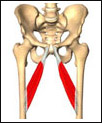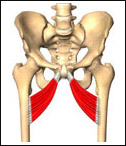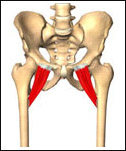This is a series on groin pain. Part 10 is about self-treatment. The previous posts give tips for treating the gracilis, sartorius and adductor magnus. For positioning and landmarks go back to Part 10a. If you missed the beginning of the groin series, go back to Part 1.

 Treat the adductor longus and brevis: In the same seated position, find the pubic tubercle (see Part 10a) and press down into the deep space to the inside of it with your fingers. That’s the attachment of the adductor longus. When contracted the muscle feels like a stick of hard sausage in the upper third of your inner thigh and can be quite prominent. The adductor brevis attachment is deep to it, accessible by pressing against the bone in your crotch under the attachment of the gracilis. You can feel both muscles contract if you start to bring your thighs together. The adductor longus and brevis muscles attach to the pelvis and run diagonally across the upper thigh to the femur.
Treat the adductor longus and brevis: In the same seated position, find the pubic tubercle (see Part 10a) and press down into the deep space to the inside of it with your fingers. That’s the attachment of the adductor longus. When contracted the muscle feels like a stick of hard sausage in the upper third of your inner thigh and can be quite prominent. The adductor brevis attachment is deep to it, accessible by pressing against the bone in your crotch under the attachment of the gracilis. You can feel both muscles contract if you start to bring your thighs together. The adductor longus and brevis muscles attach to the pelvis and run diagonally across the upper thigh to the femur.
Reach/press in beneath the gracilis with the fingers of one hand. Meet those fingers with the fingers of your other hand above the gracilis and press them together behind the gracilis to compress the bellies of these two muscles. Move closer to the femur and press again. If you feel the pulse of the artery, move a little to the side away from it. It’s difficult to harm it with your fingers, but best not to be right on it.
 Treat the pectineus: Just beside the adductor longus attachment, search for the hard bone of the “superior pubic ramus” that angles downward toward the inner thigh from the pubic bone. Stay below the inguinal ligament at the crease in your groin. Press with supported fingers (press the fingers of one hand down with the other hand) toward the chair seat into the soft tissue of the thigh. If you feel a pulse, move just a little so you’re not on the artery but keeping outside and under it. The pectineus is short. If you want to feel it contract, start to cross your legs. This muscle may be the most important one to treat if you have groin pain.
Treat the pectineus: Just beside the adductor longus attachment, search for the hard bone of the “superior pubic ramus” that angles downward toward the inner thigh from the pubic bone. Stay below the inguinal ligament at the crease in your groin. Press with supported fingers (press the fingers of one hand down with the other hand) toward the chair seat into the soft tissue of the thigh. If you feel a pulse, move just a little so you’re not on the artery but keeping outside and under it. The pectineus is short. If you want to feel it contract, start to cross your legs. This muscle may be the most important one to treat if you have groin pain.
Hold pressure on any place that hurts for 8-12 seconds or until you feel a little less pain or a softening of the muscle. If there is no change, hold for up to 20 seconds then release and repeat. Your muscles need blood to release. Letting up the pressure allows a fresh supply to flow in.
The next post is about treating the iliopsoas and tensor fasciae latae.